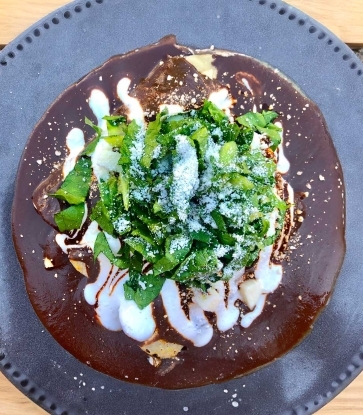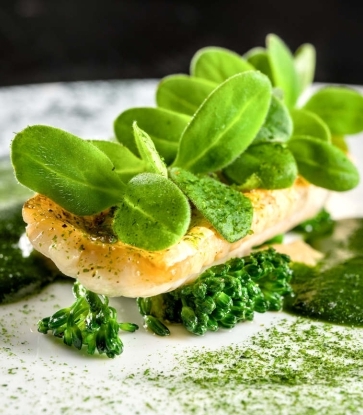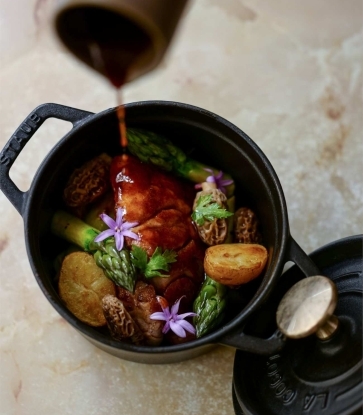The country’s green DNA is underlined by its very morphology – the Alps, Mediterranean, Karst region and Pannonian plain are truly impressive in their beauty, all of which are brought together in a single verdant landscape. “Just as the Slovenian woods and rivers are green, so too is the Slovenian approach to life – and therefore, by extension, Slovenian food. Our gardens, woods and meadows are essential to us”, says Ana Roš, the chef at Hiša Franko in Kobarid, which has just been awarded three MICHELIN stars, the first restaurant in Slovenia to achieve this recognition.
It is this biodiversity and a strong desire to protect it that explains the major focus on sustainable development in Slovenia. This is hardly surprising, given that 60% of the country is covered with forest, a fifth of the coast is officially protected, and the land is home to more than 22,000 different species of plants and animals.
It is within this context that the world of Slovenian gastronomy looks to nature as the guiding light that informs every choice made. It can be seen in the ingredients used – vegetables, wild herbs, fruits, and mushrooms from the forests; honey (produced by the indigenous Carnolian bee), which has been an important foodstuff for centuries; fish from the country’s lakes, rivers and sea; oil (both extra-virgin olive oil and pumpkin seed oil); wine; salt from the Piran saltpans; as well as cheese, charcuterie and meats. Slovenia is an abundant country that sources food from the land and sea, all of which is valued and preserved by those who transform these ingredients and serve them at the country’s many traditional and modern restaurants.
In fact, when it comes to gastronomy Slovenia has always followed the sustainable principles summed up in the “farm to fork” approach, with a focus on local, organic and seasonal produce – it’s not by chance that this country was the first to be named a European Region of Gastronomy. Here, the Slovenia Green Cuisine label is awarded to restaurants (currently 67 in number) that have made a commitment to increase their sustainable food practices. This commitment is based on precise parameters which include the promotion of food specialties and authentic, seasonal dishes from the local area and an emphasis on the importance of short supply chains with high-quality local suppliers; serving guests fresh tap water (another of the country’s superb resources) which is of high quality and does not require packaging; and working to reduce food waste, eliminating disposable plastic and committing to a sustainable use of natural resources.
It is common knowledge that the way we manage food has a significant economic, social, and environmental impact, both for businesses and for their communities. This is why tackling food waste is one of the most important concrete actions to be taken to transform food systems for the benefit of the planet, its people, and its prosperity. For this reason, Slovenia is working to implement a pilot project to reduce food waste in local restaurants and the tourism sector in general: this will provide a general roadmap focusing on key principles such as avoiding the generation of food surpluses and waste and the promotion of circular processes that bring added value, such as recycling (or composting, anaerobic digestion and land-spreading) and energy recovery.
Organic and zero-mile production, growing vegetables and foraging, zero waste, conserving and fermenting food, the use of tap water, serving farm-to-fork ingredients – all of these are of prime importance in Slovenian cuisine, which looks to tradition to evolve yet never forgets its roots and local values. To explore this further, let’s take a look at some of those involved in promoting the country’s culinary traditions. Inspired by centuries-old history, they source their ingredients from the country’s unspoilt natural landscapes, which inspire wine-growers and vegetable producers to focus on quality and sustainability. We are talking, of course, about the seven Michelin Green Star restaurants that feature in the latest edition of the Michelin Guide, in which a total of 59 Slovenian restaurants are listed.
ŠPACAPANOVA HIŠA – Ago Špacapan – MICHELIN selected and Green Star
A staunch advocate of cuisine from the Karst region, chef Ago Špacapan delights his guests with exquisite dishes that have their roots in local traditions. Ago grew up cooking at the family restaurant, where his parents were at the helm in the kitchen: Špacapanova Hiša remains a family-run restaurant today, with the chef’s mother Ada working in the kitchen, his father cultivating the kitchen garden and producing the local wine, called teran, and his sister helping to run the business. Everything on the menu at Špacapanova Hiša is traditional and looks to the land, so it’s hardly surprising that the restaurant has been awarded a MICHELIN Green Star this year.
The menu features local ham, beef carpaccio, home-made soup, and pasta prepared with local butter and brewer’s yeast, as well as ravioli filled with Špacapan krodiga (pork skin sausage), lamb, game and aged beef. Each dish offers a glimpse of the region, its history and everything that has been celebrated here over the centuries. And just like in the past, its people are of primary importance – as an example, the Špacapans process their own ham. “You can only be guaranteed top-quality ham if you make it yourself. The pigs must be fed properly, with no preservatives or artificial additives”, explains the chef, who allows his ham to age for three years before serving it to guests. The same is true for their bread, which is made using a natural sourdough process because it is easier to digest and tastes better. Time is also an important factor in this food revolution.
In this region, they say that you have to take time over food – time to eat it and time to prepare it. The dishes reflect a harmony of flavours that have their roots in the past yet also look to the future. Even the number of tables contribute to the family atmosphere: sixteen tables in all – six in the garden and ten in the dining room.
HIŠA FRANKO – Ana Roš - 3 Michelin stars and Green Star
2023 was a magical year for Ana Roš Stojan, the chef who has long been the face of Slovenian cuisine around the world. This year, Hiša Franko became the first restaurant in Slovenia to be awarded three MICHELIN stars, becoming the 140th restaurant in the world to achieve this much-coveted accolade. This self-taught chef, who began cooking out of a love for cuisine, has always demonstrated respect for nature and her surrounding region, which she showcases in dishes that change according to the weather, seasons, climate and the influence of the sun and the moon.
Local ingredients always take pride of place, combined with influences from elsewhere around the world. Working with local producers and farmers (such as Matteo Monterumisi and his wife Jeanne Dumas Chalifur, who cultivate organic fields and gardens in which they grow around 350 kinds of vegetables and cereals in the mountain village of Srednje in Ročinj, around 40km from Kobarid) is of utmost importance to her. She does this alongside her right-hand man, Colombian-born Leonardo Fonseca, and a team of staff from across the globe. Ana Roš Stojan is inspired by her local terroir, enhancing her cuisine with wild herbs and foraged ingredients, trout from the Soča river, and local Tolminc cheese (made from cow’s milk), which she serves paired with the natural wines for which Slovenia is renowned. And this is the true meaning of sustainability – working with the local land and its people, collaborating with biodynamic farms, and creating a strong relationship with local producers so that everyone can develop together. “However, doing this, you have to maintain your own unique character and know how to express yourself”, she reminds us. This is how she and her partner (and ex-husband) Valter Kramar transformed Hiša Franko, the old village inn in Franko Kramar, into a culinary institution that has succeeded in showcasing Slovenia internationally and taken Slovenian gastronomy to the very highest level.
Her dishes take guests on a journey through the Soča valley and its surroundings, introducing them to ingredients such as cottage cheese and cheese from Drežnica goats, čompe (potatoes) cooked in hay, and wild herbs and flowers from nearby woods and meadows. Ana doesn’t use traditional luxury ingredients: she replaces caviar with trout roe and salmon with anchovies. Hers is a very personal cuisine, often linked to memories and flavours from her childhood as well as to the present – it is as authentic, sincere, bold and original as the chef herself.
GRIČ – Luka Košir – 1 Michelin star and Green Star
Regionally inspired cuisine takes pride of place on the menu at Luka Košir’s Grič restaurant in the small village of Šentjošt nad Horjulom. Having grown up in this village, Košir has forged a strong connection with his surroundings: “I would never go and live anywhere else, and this allows me to express my identity to the full”, he tells us. His identity brings with it a deep knowledge of the land around him. This includes the mushrooms picked in the woods in autumn, or the lichen gathered in winter; local produce, such as vegetables grown in his own kitchen garden (the restaurant grows 80% of its own vegetables); and ducks reared on the farm itself, the first in Slovenia to receive organic certification.
In this restaurant, which was awarded its green star back in 2020, Košir works with methods that are important for self-sufficiency, including techniques such as acidification, salting, curing, smoking and fermentation – he also makes his own brandy, jams and compotes. His avant-garde cooking focuses on vegetables and incorporates traditions from Scandinavia, Asia and Slovenia. He makes miso paste from beans and pickles his own produce and preserves it via lacto-fermentation. Continually bursting with ideas, Luka creates artistic cuisine thanks to his ability to work imaginatively with everything that nature has to offer. “People need to know where their ingredients are sourced. This is even more important in Slovenia, where everything is available, and we don’t have to go far to find good produce”.
This approach is rooted in a local identity that tells the stories of people, places and traditions through cuisine. Wild leek, shiitake mushrooms and dandelion flowers often accompany home-reared Krškopoljec pork or smoked duck breast – both these meats originate from his own organic farm. He also uses local ingredients and delicacies such as crab, prawns and scallops from Slovenia’s Adriatic coast. “I love cooking over fire, which is the main component in my cooking, but I also prefer not to write my recipes down so that I am always thinking about new dishes and ways to improve”, he concludes.
MAHORČIČ – Ksenija Krajšek Mahorčič – Bib Gourmand and Green Star
In the area encompassing the Brkini hills and the Karst, Ksenija Krajšek Mahorčič tells the story of this region through her cuisine. A self-taught chef who came to cooking through her love for her husband Martin, who belongs to a family of restaurateurs dating back four generations, Ksenija uses her gentle touch to create dishes that are influenced by the sea and the mountains alike.
Her first introduction to the culinary arts (to which she remains closely attached) was through desserts and appetizers that she prepared herself, with techniques that are also evident in other dishes on the menu. Her desserts include potica, a traditional Slovenian cake made with rolled dough conserved in a glass container; sorbet, made with pears from the Brkini orchards and served on a block of ice containing juniper berries; and a Jamar cheese flan, a speciality made with truffles and a crispy egg yolk, and based on an old local recipe that uses this slightly spicy cheese.
Meanwhile, her savoury dishes are traditional in flavour, with seasonal variations. In winter, the menu features jota stew which, as the seasons change, is followed by wild garlic soup, young peas with mint, barley, cauliflower with orange, and truffles. Ksenija demonstrates her respect for the region in which she works and its local producers by using produce grown in her small kitchen garden next to the restaurant, or sourced from neighbouring farms, and by championing Slovenian truffles, as well as fish bred highly sustainably by the Fonda fish farm. “When I taste my dishes, I taste the flavours of this region and its forests and local vegetable gardens. These fully reflect the way we choose to live our lives, and our way of living close to nature and its biodiversity”, the chef tells us.
GOSTILNA KRIŠTOF – Uroš Gorjanc – MICHELIN selected and Green Star
Situated some 40 minutes from Ljubljana, this traditional inn is run by Krištof Bolka and chef Uroš Gorjanc, both of whom are motivated by a strong passion for their work – a passion that is evident in the welcome that awaits guests and the vision behind every dish served.
The cuisine here demonstrates a true respect for ingredients and guests alike, with diners offered a welcome grape and ginger juice (made with grapes from the garden) on arrival that provides an indication of how important nature is here. The cuisine is based on traditional recipes, with the use of fresh, locally grown ingredients and modern French-influenced cooking techniques (note the versatile use of butter), as well as the many other countries in which Uroš Gorjanc plied his trade before settling here. Gostilna Krištof is also a focal point for the community – a place where farmers come to sell their local produce and locals come to buy fresh bread and pastries from the bakery that the owners have opened next door to the restaurant.
“I have the utmost respect for top-quality ingredients, as well as for the local farmers and growers who use their knowledge, experience and traditions to produce them – this is the only way that cuisine can develop and modernise”, says Gorjanc. His dishes, which showcase a perfect balance of flavours and textures, are a real declaration of love for this land. A good example is the trout tartare served with oil, sage, local caviar and an egg-free mayonnaise made with pine nuts and anchovies. The ingredients in this dish tell the story of the region – the trout is caught in a local lake just 10km from the restaurant, where the water temperature remains constant throughout the year. Another excellent example is the sweet-chestnut ravioli stuffed with cooked pears and served with a sweet chestnut cappuccino, cherry vinegar and local cheese.
GOSTILNA REPOVŽ – Meta & Sabina Repovž – Bib Gourmand and Green Star
This inn with rooms (which is also an organic farm) nestled in the Slovenian countryside is run by the sixth generation of the Repovž family. Situated between the regions of Posavje and Dolenjska in the village of Šentjanž (population 400) in south-east Slovenia, this restaurant is the perfect setting for anyone keen to try contemporary rural cuisine which the owners describe as being “for good souls and inquisitive appetites”. At the helm of the restaurant, Meta can be found in the kitchen creating home-made dishes inspired by places and people, while her son Grega works front of house overseeing the dining room and the wine list. The menu is deliberately simple, featuring dishes such as beef soup, štruklji (cheese dumplings) and chicken paprikash.
The restaurant is committed to local produce, and those ingredients that are not grown or produced on their own farm are sourced from local suppliers. When you eat at Gostlina Repovž you know where the eggs were laid, where the meat comes from, who made the cheese and who produced the beer served with your meal. “We are proud of our suppliers”, they explain. “We have built an honest and open relationship with them – one based on learning and growing together. We are aware that having a good knowledge of our ingredients and how they are produced is fundamental to creating high-quality dishes. As a result, we know that every dish we serve is made from fresh ingredients that have been produced with care and expertise by people with whom we work every day, in so doing forging a relationship that is all about learning and growing together.”
The Bunka cider is made by Grega’s younger brother Anže from apples grown in their orchard; Meta’s right-hand woman is Grega’s wife, Sabina, a pastry specialist; while Meta’s husband, Jože, is in charge of the farm, which was one of the first in Slovenia to be certified as organic 20 years ago. The farm covers an area of 40 hectares, of which 3.5 hectares are planted with apple orchards where Topaz apples and a few older varieties are grown. In addition to cider, the Repovž also make apple vinegar, apple juice, an apple liqueur (a kind of Slovenian calvados), dried apple slices and the apple desserts served in the restaurant. They grow many different fruit and vegetables, as well as cereals, all of which make an appearance on the menu. Local specialities such as green beans with crackling, soup with rolled dumplings, stew, and flatbreads also feature, as well as meat-based salads, sauerkraut and potatoes, and salad with marinated pine shoots.
HIŠA LINHART – Uroš Štefelin - 1 MICHELIN star and Green Star
At Hiša Linhart in Radovljica in the north-west of the country, chef Uroš Štefelin uses modern ideas and techniques to take traditional Slovenian cuisine to a higher level. His cuisine is enhanced using local ingredients grown either in his own kitchen garden or sourced from neighbouring farms, all of which play a starring role in creative dishes that reinterpret traditional Gorenjska recipes and are full of flavour and colour. Exotic ingredients are banned from his cuisine: “We’re not looking to create a wow effect simple by using unfamiliar flavours,” the chef explains, demonstrating how combinations of various Slovenian ingredients can also create different and interesting flavours.
Uroš Štefelin believes strongly in Slovenian culinary heritage and often finds inspiration for his cuisine in old local cookery books. He works closely with a strong network of local farmers, who offer suggestions on ingredients, produce and what to grow, including the occasional heritage variety, such as the Tepka pear: “These pear trees were being cut down because they grow alongside roads and make it difficult to widen them, but now they are being planted and protected, and the pears are used for an array of different purposes, from making brandy to dried fruit.” At Hiša Linhart, these pears are used as a stuffing for pasta, along with Carniolan sausage, or sometimes served with freshwater crayfish.
Hero image: Hiša Linhart, Radovljica
Read also





















